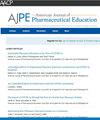Deficiencies in Mathematical Skills Identified in First-Year Students at Two Pharmacy Institutions
IF 3.5
4区 教育学
Q1 EDUCATION, SCIENTIFIC DISCIPLINES
引用次数: 0
Abstract
Objective
Describe the mathematics ability of incoming student pharmacists at 2 US pharmacy institutions.
Methods
A baseline mathematics assessment (BMA) was administered to first-year students (P1) during orientation at 2 public, 4-year pharmacy schools over 4 years. The assessment questions incorporated basic mathematics principles needed for pharmacy calculations, without pharmacy-specific terminology. A survey of students’ prior mathematics experience, pharmacy experience, perceptions of mathematics ability, and native English speaker status followed the assessment. Descriptive statistics were used to summarize performance based on question category. Overall performance and performance by category were analyzed using t-tests. One-way analysis of variance was used to evaluate survey responses.
Results
The BMA was completed by 922 students during the 4-year study period. The mean score was 73.8% (range: 26.6%–99.2%). Students performed best in the categories of rounding (88.9%), fractions and decimals (86.8%), and proportions (85.8%). The category with the lowest performance was conversions (29.7%). Overall performance differed significantly between the 2 schools. Students who self-identified as native English speakers performed significantly better than those who did not. Students’ self-ratings of mathematics ability aligned with their performance.
Conclusion
The assessment revealed variation in mathematics proficiency and identified areas of weakness for incoming student pharmacists.
两所药学院校一年级学生数学技能的不足。
目的:描述美国两所药学院校即将入学的药学学生的数学能力。方法:对两所公立四年制药学院的一年级新生进行基线数学评估(BMA)。评估问题纳入了药学计算所需的基本数学原理,而没有药学专用术语。在评估之后,对学生先前的数学经验、药房经验、对数学能力的看法以及学生是否以英语为母语进行了调查。基于问题类别,采用描述性统计对表现进行汇总。总体表现和类别表现采用t检验进行分析。采用单因素方差分析对调查结果进行评价。结果:922名学生在四年的学习期间完成了BMA。平均得分为73.8%(范围:26.6% ~ 99.2%)。学生在四舍五入(88.9%)、分数和小数(86.8%)和比例(85.8%)方面表现最好。表现最差的类别是转化率(29.7%)。两所学校的总体表现存在显著差异。那些自认为以英语为母语的学生比那些不以英语为母语的学生表现得好得多。学生对数学能力的自我评价与他们的表现一致。结论:该评估揭示了药学新生在数学熟练程度上的差异,并确定了其不足之处。
本文章由计算机程序翻译,如有差异,请以英文原文为准。
求助全文
约1分钟内获得全文
求助全文
来源期刊
CiteScore
4.30
自引率
15.20%
发文量
114
期刊介绍:
The Journal accepts unsolicited manuscripts that have not been published and are not under consideration for publication elsewhere. The Journal only considers material related to pharmaceutical education for publication. Authors must prepare manuscripts to conform to the Journal style (Author Instructions). All manuscripts are subject to peer review and approval by the editor prior to acceptance for publication. Reviewers are assigned by the editor with the advice of the editorial board as needed. Manuscripts are submitted and processed online (Submit a Manuscript) using Editorial Manager, an online manuscript tracking system that facilitates communication between the editorial office, editor, associate editors, reviewers, and authors.
After a manuscript is accepted, it is scheduled for publication in an upcoming issue of the Journal. All manuscripts are formatted and copyedited, and returned to the author for review and approval of the changes. Approximately 2 weeks prior to publication, the author receives an electronic proof of the article for final review and approval. Authors are not assessed page charges for publication.

 求助内容:
求助内容: 应助结果提醒方式:
应助结果提醒方式:


